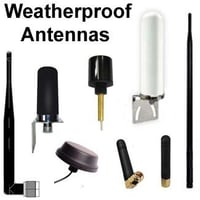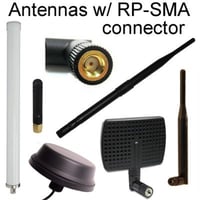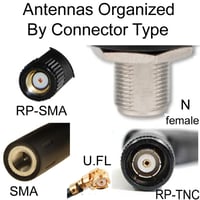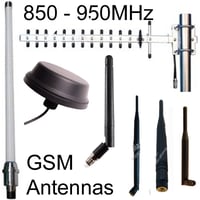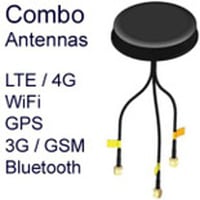Dipole Antennas: 900MHz
Dipole Antennas: 850-950MHz:
Dipole Antennas of the 850-950MHz frequency band are omnidirectional antennas used for the Global System for Mobile Communication (GSM), CDMA, and ISM applications including LoRa. The dipole antenna mates with the wireless access points that have a female connector and operate in the 900MHz.
The dipole antennas come with a male connector of one of the following connector-types: RP-SMA, SMA, Type-N, or RP-TNC. Most typically, they have an articulating right-angle with the elbow just above the connector. Articulating right-angle is not a waterproof / weatherproof type of antenna. If you need a weatherproof antenna, choose one with a fixed right angle or straight (no right-angle).
850-950Mhz and Obstructions
The 850-950MHz band is a non-licensed ("free") low radio frequency band that provides a relatively long wavelength emitted in a radiated pattern, making it very effective against obstacles such as trees, forests and buildings. Due to the relatively long wavelengths, it is popularly used in GSM applications both inside and outside. It has been known to penetrate multiple walls while maintaining good reception. With its wave diffraction, the radio frequency band is particularly effective in no line of sight and near line of sight transmissions.
850-950MHz Applications
The 900MHz band is used for for point to multiple point and point to point usage in the following applications:
- 900 MHz Cellular applications: GSM 2G & CDMA
- LoRa: A low power long range ISM wireless technology that enables wireless for IOT (Internet of Things) devices for industrial communications over long distances.
- WLAN applications
- Supervisory control and data acquisition (SCADA)
900 MHz dipole antennas: Deep Dive
900 MHz dipole antennas are resonant at frequencies that lie between 850 and 950 MHz. This frequency band, known as the 900 MHz band or the 33-centimeter band supports a range of sub-gigahertz radio frequency communications. Applications span cellular communications , amateur radio, and an emerging class of low power wide area networking. As dipole antennas, they have a basic structure consisting of 2 conductive elements with a feedline in the middle. These antennas are ‘balanced’ antennas as the two poles are of equal length. They may vary in length, gain, and other physical and electrical characteristics but are typically omnidirectional antennas that can be used to increase signal range for connectivity in this commonly used portion of the spectrum. Dipole antennas are made from brass, copper, or copper-coated steel with insulation at the feed point and ends of each conducting element. Insulators are essential for structural support and to isolate the voltage across the antenna wire. They are usually housed in a plastic or rubber tube-shaped radome and have an antenna connector attached to the feedline to permit easy connections to cabling and radio devices.
For a dipole antenna to operate optimally at its specified frequency, its length must be equivalent to a half wavelength of the operating frequency. In the 900 MHz range, this equals approximately 16.6cm (a full wavelength is 33.3cm). Resonance within the dipole antenna occurs at the length where there is no electrical reactance. The frequency where this first occurs for the antenna is known as its fundamental frequency. 900 MHz dipole antennas have electrical compatibility with the radio frequency circuits they are connected to as they have 50 Ohm impedance and utilize standard radio frequency connectors like SMA, RP-SMA,and TNC.
Why is a 900 MHz dipole antenna important?
Signal propagation at 900 MHz is key to supporting a wide range of applications.
This sub-gigahertz frequency band is advantageous due to its ability to support long-range communication. The 70-centimeter band (433 MHz) is known for its long-distance signal propagation but a well-positioned 900 MHz antenna of higher gain can achieve equivalent distances with good signal quality and low noise floor. If antenna gain and transmitting power are equivalent, a 900 MHz dipole antenna will achieve about 75 percent of the distance of a 433 MHz antenna. Transmission distances at 900 MHz are over 1.5 times greater than at 2.4 GHz. Because longer distances can be achieved with less transmitting power than higher frequencies, 900 MHz is a candidate for low power, battery-operated solutions.
Line of sight is needed for optimum performance of transmitting and receiving antennas, meaning outdoor installations that use this frequency are typically mounted at height, with obstructions kept to a minimum. Compared to frequencies above 1 GHz, the 900 MHz frequency band is more resilient to multipath interference, but other devices that use the 900 MHz frequency like baby monitors or cordless phones produce interference which is penetrative and may be hard to rectify. 900 MHz has less bandwidth and lower data throughputs than at higher frequencies like 5 GHz.
Signal penetration at 900 MHz is better than at higher frequencies like 2.4 GHz. Transmitted signals can penetrate windows, walls, and even concrete blocks. Metals will reflect signals and restrict coverage.
Dipole antennas are a simple effective solution for a wide range of communications at 900 MHz.
Dipole antennas are a convenient option for a reliably performing antenna that can operate consistently on a single frequency, in a range of environments. External dipole antennas are typically selected to improve coverage and performance of the networks discussed further on. Types include half-wave 900 MHz dipole antennas, quarter-wave 900 MHz dipole antennas, or compact stub 900 MHz antennas which can be mounted directly onto a device or terminal. The rotating and articulating designs of dipole antennas also offer advantageous levels of flexibility. A 90-degree articulation radius increases the ability to optimally adjust the coverage of the antenna and ensure that polarization is properly matched. Dipole antennas for outdoor installation should not articulate to prevent moisture ingress. High-quality dipole antennas utilize good materials, fabrication methods, and efficient power transfer to support sensitivity within their frequency range.
Dipole antennas like the classic ‘rubber duck’ antenna are omnidirectional with an antenna pattern that has 360-degree coverage in the horizontal plane and approximately 75 degrees along its axis. Dipole omnidirectional antennas can also be ceiling mounted for coverage across an entire room.
900 MHz dipole antennas for cellular communication
The Global System for Mobile Communications (GSM 900) is a widely used cellular technology which delivers second-generation (2G) digital circuit-switched cellular networks across the world. The second-generation cellular networks use digital encryption for full-duplex voice telephony and SMS messaging, with efficient use of the radio spectrum that means that more users can use each supporting frequency band. It is also characterized by the requirement of a Subscriber Identity Module (SIM) card; a detachable smart card that contains the cellular device user’s information and contacts. GSM also supports packet data transfer via the General Packet Radio Service (GPRS) or Enhanced Data Rates for GSM Evolution (EDGE). GPRS and EDGE extend the service capabilities of GSM to support internet connectivity and multimedia messaging.
The 900 MHz frequency has widespread use by GSM devices, particularly in Europe, Africa, the Middle East, and Asia. GSM-850 predominates in North, Central, and South America. A 900 MHz dipole can be used to boost 900 MHz cellular connectivity as part of a GSM-900 cellular booster or repeater. Cellular repeaters can not only enhance a 900 MHz cellular signal but improve access and connectivity to GSM data services. GSM signal boosters may be needed in remote areas, regions with significant obstructions (hills or vegetation), or large building size. These devices consist of an outside ‘donor’ antenna which feeds the 900 MHz cellular signals to a GSM channel repeater which amplifies the signal and sends it via antenna cable to an indoor 900 MHz antenna. Both the donor and recipient antennas must be suitably isolated (usually by distance) from one another to prevent severe interference, and the indoor external 900 MHz antenna can be positioned within a building for optimal utility. The recipient antennas are usually omnidirectional antennas to provide good indoor coverage.
900 MHz dipole antennas for wireless links
900 MHz is commonly used as a sub-gigahertz frequency for creating robust wireless links, with higher power and increased range. This is advantageous where there may be vegetation that can interfere with signal propagation at higher frequencies. 900 MHz point to point links are also a viable alternative for creating connections that cannot be readily achieved via the 802.11 protocol at 2.4 or 5.8 GHz. 900 MHz base stations can be used to create an internet backbone or ISP network with dipole antennas attached to the base station RF connector outlets. With a clear line of sight, connectivity can be maintained over large distances with less path loss, but speeds and data throughput are usually lower.
900 MHz antennas for Low Power Wide Area Networking (LP-WAN)
LP WANs are long-range networks, usually connecting participating objects with low-bit rate, low energy, battery-powered connectivity. The low data rate, usually around 50 kbps, distinguishes these networks from higher throughput networking like WiFi. The networks created may be local or private networks or large scale infrastructural networks for utilities or other services. At sub-gigahertz frequencies like 900 MHz, less energy is needed to transmit signals over longer distances with greater penetration than at 2.4 or 5.8 GHz. LP-WANs are designed to be simple and scalable with star or mesh network topologies with a central controller. Networks usually have hierarchies of connected objects which may be capable of bidirectional communication, intermittent transmission, or routine signaling.
Many proprietary and open-source networking protocols and technologies exist for LP-WANs that operate at 900MHz including:
- LoRa WAN
LoRa is a low power, wide-area networking protocol owned by Semtech. It uses the 900 MHz frequency band in North America. LoRa uses a modified chirp spread spectrum modulation technique for intermittent, low data rate connectivity between objects that carry LoRa chipsets, with transmission distances of over 10 kilometers (6.2 miles) in optimum conditions. Devices transmit their data asynchronously and data packets are forwarded to the network controller through sequential nodes in a mesh network arrangement. Dipole 900 MHz antennas are used in these networks to enhance network coverage and sensitivity. Depending on the data transferred LoRa is capable of geolocation and tracking functionality. Large scale LoRa deployments include regional utility metering, environmental and ecological surveillance, and the Internet of Things.
- SigFox
SigFox provides a turnkey LP-WAN that provides coverage in over 70 countries using Ultra Narrow Band (UNB) connectivity for efficient use of its carrier frequency. It operates at 900 MHz in the US. It uses phase-shift keying modulation techniques for data transfer using license-free frequencies. 15.5 million objects are already connected and this wireless technology remains a contender for being the leading networking standard for the Internet of Things (IoT). Networks are deployed for solutions such as smart metering and waste management. SigFox supports connectivity in battery-operated devices that send their small data packets (up to 140 100 bit data packets per day) over long-distances (and even underground) using one-hop networking with star topology.
- NB-IoT
Narrow Band Internet of Things (NB-IoT) is a LP-WAN networking standard that is produced by the Third Generation Partnership Project (3GPP). It equips a broad range of cellular devices with low power, wide-area connectivity using a narrow, 200 kHz band within the licensed spectrum. As it uses such a small portion of the 900 MHz frequency band, NB-IoT can be used simultaneously alongside GSM and LTE. As it uses cellular carrier frequencies it has no duty cycle restrictions and therefore is marketed as a robust solution for IoT networked devices that need to communicate frequently. NB-IoT provides reliable indoor connectivity and, as it utilizes existing cellular network infrastructure, it is highly scalable and able to support up to 50,000 devices per cell. It also takes advantage of the superior encryption and security protocols used by cellular networks.
900 MHz dipole antennas for IoT / M2M
IoT and Machine 2 Machine networking are reliant on antennas with the physical and electrical specifications that can support both the sustained connectivity and intermittent transmissions of networked objects. IoT antennas must be carefully evaluated for their bandwidth, range, energy consumption, and impact on battery life.
Omnidirectional dipole antennas provide the performance and coverage necessary to support the low latency and low throughput communication over distance consistently and for prolonged periods. Whip, rubber duck, and wire antennas are routinely used in IoT networking due to their relatively low cost and simplicity. They are versatile and can be used to create star and mesh networks as well as simpler point to point links.
External antennas that are ground plane independent can connect directly to devices via an appropriate PCB mounted connector. They have higher gain than internalized antennas and improved visibility. Articulating or rotating dipole antennas can be precisely positioned for optimal performance.
900 MHz antennas for WiFi HaLow
WiFi HaLow is a WiFi networking standard (802.11ah) released in 2017. It is distinct from the other leading WiFi standards as it uses license-free portions of the 900 MHz frequency band rather than the commonly used 2.4 GHz and 5 GHz frequencies. It has extended range (approximately 1 kilometer / 0.62 miles) and lower energy consumption than its standard counterparts, making it a solution for bringing connectivity into more remote areas. Signal penetration, which can be an issue with higher frequency versions of WiFi, is improved at the 900 MHz frequency and traffic is less.
HaLow is also targeted at M2M and IoT applications and is capable of supporting thousands of networked devices via a single access point and have scheduled wake/doze periods to minimize energy consumption. Data rates of up to 347 Mbps can be achieved using a variety of modulation techniques including Orthogonal Frequency Division Multiplexing (OFDM).
900 MHz antennas for amateur radio
In the United States, amateur radio enthusiasts also use the 33-centimeter band for a range of recreational uses that also use the other well known Ham radio, frequency bands. The allocation is secondary to other uses so amateurs must tolerate any interference that arises. 900 MHz amateur equipment specifically designed for amateur use is not widely available so many enthusiasts use cellular mobile and handheld radios or self-build transverters. 900 MHz Ham radio activities include:
- Continuous Wave and Single Side-Band
- Fast Scan TV
- FM
- Amateur Television
- Building and using repeaters
Frequently asked questions
900 MHz versus 2.4 GHz what are the key differences?
- Signal transmission over 900 MHz suffers less free space loss (attenuation) than at 2.4 GHz. At 2.4 GHz, attenuation is up to 8.5 dB more than at 900 MHz irrespective of distance.
- The effects of atmospheric attenuation (signal loss due to rain or fog) are greater at 2.4 GHz
- At 2.4 GHz antenna gain for antennas of comparable size and design is higher than at 900 MHz.
- Greater Fresnel Zone clearance is needed for signal propagation at 900 MHz (38 meters / 125 feet versus 23 meters / 75 feet at 2.4 GHz).
- The two frequencies vary in their Effective Transmit Power Limitations, with greater transmit power allowances at 2.4 GHz.
- 900 MHz has a greater ability to penetrate vegetation, though the signal may be degraded.
What are ground plane independent antennas?
Ground planes are flat conductive surfaces that reflect electromagnetic energy that is being emitted from other parts of the antenna and influences the antenna’s overall radiation characteristics. Ground planes are usually at least a quarter wavelength in diameter (usually a metal disc, or the metal roof of a vehicle). Ground planes can be integrated within the mounting of the antenna.
Ground plane independent dipole antennas do not require a ground plane to function optimally. They therefore can be mounted on any surface conveniently. 900 MHz quarter-wave dipole antennas need a ground plane to operate properly which would be a metal disc with a diameter of at least 3 inches.
In conclusion
The 900 MHz frequency band supports a broad range of cellular and wireless networking applications and is a leading frequency for IoT and M2M networking. Dipole antennas are a convenient and flexible option for reliable and easily adjusted wireless network coverage at this frequency. Standard radio frequency connectors like SMA and RP-SMA connectors on these antennas make 900 MHz dipole antennas easy to integrate into devices and networks.
LEARN MORE:
- LoRa
- NB-IoT
- Internet of Things protocols

